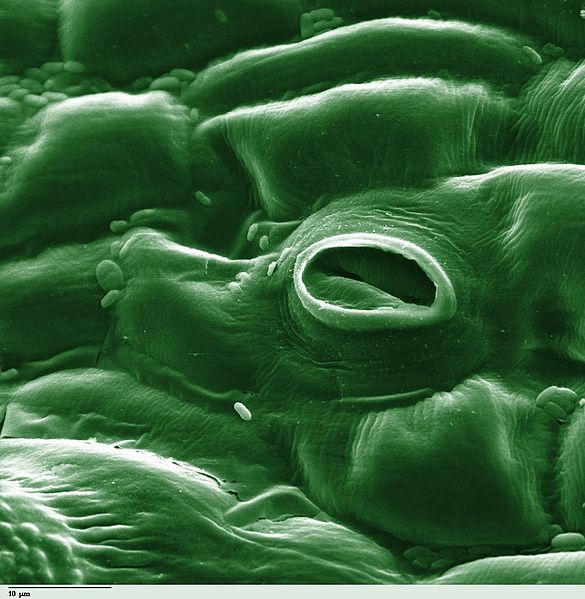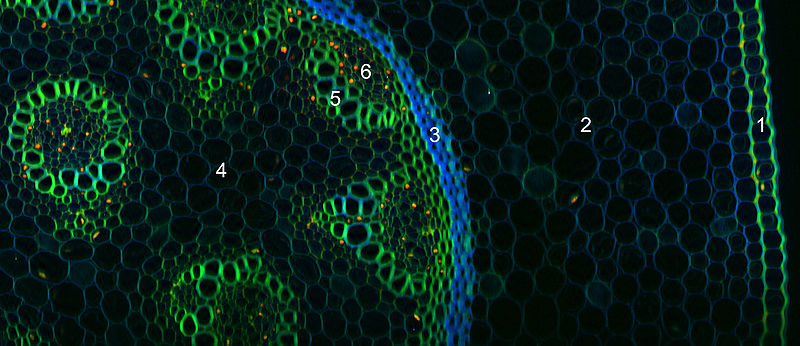Nutrition
 B. excelsa is very similar to most plants when it comes to
acquisition of food. The main source of “food” acquisition
comes from the photosynthesis that takes place on the cellular
level throughout the plant. With the crown of the tree
being so high over the canopy in the Amazon, light is usually
very plentiful for the leaves of B. excelsa, which allows for
plenty of photosynthesis to take place. In addition to
food production, the leaves also serve as sites for gas exchange
with the environment through the use of stomata (right). The xylem in the trunk of the plant
work to transport water from the roots of the tree to the top
and throughout the trunk, and the phloem transports nutrients
(such as the food created from photosynthesis) from the top of
the tree and the branches to the lower parts of the tree.
Excess food in the tree is stored as starch.
B. excelsa is very similar to most plants when it comes to
acquisition of food. The main source of “food” acquisition
comes from the photosynthesis that takes place on the cellular
level throughout the plant. With the crown of the tree
being so high over the canopy in the Amazon, light is usually
very plentiful for the leaves of B. excelsa, which allows for
plenty of photosynthesis to take place. In addition to
food production, the leaves also serve as sites for gas exchange
with the environment through the use of stomata (right). The xylem in the trunk of the plant
work to transport water from the roots of the tree to the top
and throughout the trunk, and the phloem transports nutrients
(such as the food created from photosynthesis) from the top of
the tree and the branches to the lower parts of the tree.
Excess food in the tree is stored as starch.
This photo is a cross-sectional view of a plant. The xylem and phloem are on the inside of the plant and lie near to the center. The xylem (#5) lies deeper in the stem than the phloem and is responsible for the transportation of water in the plant (from the roots to the upper regions). The phloem (#6) lies next to the xylem and is responsible for the transportation of sugars and nutrients throughout the plant (from the source of food production to the structures using the food). In this particular photo, the xylem and phloem are positioned outside of the pith (#4) and medial to the endodermis (#3). Beyond the endodermis are the cortex (#2) and the epidermis (#1)
A Brazil nut is one of the more exotic nuts that can be commonly
found throughout the United
States. These delicious nuts can
be found in a majority of grocery stores, and are often used in
premium nut mixes. The Brazil nuts are not considered to be
premium simply because they must be imported, but because they are
loaded with nutritional value that rivals most other common nuts
such as cashews or peanuts, specifically in selenium concentration.
The amount of selenium in just one ounce of Brazil nuts is
approximately 780% of one's daily intake. These high levels of
selenium help to produce antioxidant enzymes, which help protect the
body against damage and diseases such as cancer and heart disease
(see more at
Brazil Nuts, Health, & Digestion!). Simply eating Brazil nuts instead
of a fatty snack on a regular basis can dramatically reduce intake
of saturated fat and improve lipid profile as well as microvascular
function. This regular intake of Brazil nuts, over time, can
actually lead to an overall healthier diet and help combat obesity.
The photo above is used to compare the different body sizes found throughout individuals. In the United States, none of the three images are out of the ordinary, which is a big concern. The image to the left depicts an average body size, the middle image depicts an overweight individual, and the right image depicts an obese individual. Brazil nuts are a viable alternative to fatty snack foods, and could potentially be a step towards a healthier life for anyone.
To learn more, continue to the Reproduction page!
